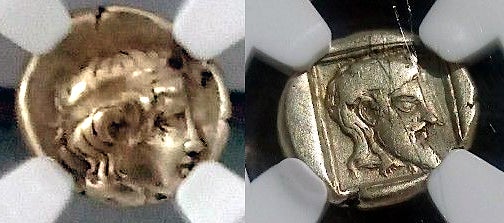
Mytilene, Lesbos: 1/6 Stater (a Hekte), 454-427 BCE
Head of youthful river god (r), hair bound in a taenia
Head of bearded old river god/saytr (r), within an incuse square
Isle of Lesbos, Mint: Mytilene
Strike grade 4/5; Surface grade 4/5; 10 mm; 2.50 g Electrum (ca. 42% gold)
NGC XF, Bodenstadt 52; SNG von Aulock 7731; Traité II-2, 2173
Coppola Collection
Lydia is the name of the kingdom comprising the western edge of Asia Minor (the Asian half of modern-day Turkey), and it existed from about 1200-550 BCE (the area was conquered by Alexander the Great in 546 BCE and brought into the Roman Empire).
Lydia was one of the first places to stamp coins using precious metals. Electrum was a natural alloy of gold and silver, available locally, and was largely controlled by the Lydian kings who turned some of it into coins by applying a design on lumps of electrum of consistent weights.
Lesbos is the large island tucked into the Asia Minor peninsula, about 10 miles from the coast (south of Troy, north of Izmir). Mytilene was its capital city. The electrum coinage from the Mytilene mint (447-326 BCE) had an average gold content of 42 +/- 14% (according to Bodenstadt’s analysis of over 50 coins from that era).
The typical weight of a coin was 4.7 grams, and this was considered 1/3 of the standard (stater). Three of these coins (1 stater or “standard”; 0.50 ounce or 14.1 g) was about one month’s pay for a soldier. The 1/3 coin was called the trite (third). This coin is a hekte (sixth), coming in a 2.3-2.5 g or about half of the trite. The denominations went down to 1/96 (about 0.005 oz). Electrum remained as the coin of the realm until about 350 BCE, when coins of more predictably purer gold and silver began to take over.

